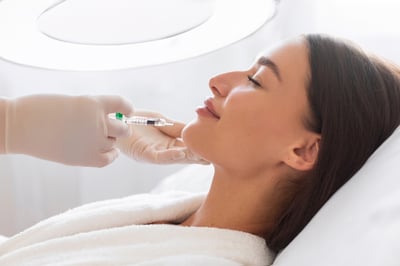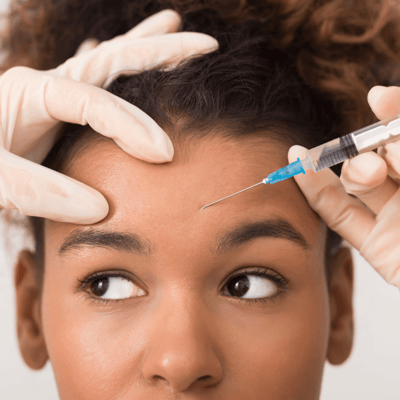
When most people hear “Botox®” or “dermal fillers,” they picture smoothed foreheads, softened crow’s feet, or plumped lips.
It’s no surprise, of course: The popularity of Botox® and other neuromodulators have surged in recent years — a jump of 73% between 2019 and 2022, the American Society of Plastic Surgeons reports. Younger generations are especially curious, with the American Academy of Facial Plastic and Reconstructive Surgery reporting that 75% of plastic surgeons have seen a
significant increase in injectable use in patients under age 30 (a trend being dubbed “prejuvenation”).
Yet, despite their widespread popularity for more well-known reasons, injectables have also quietly evolved into a versatile tool in aesthetic and medical care. From novel Botox® uses to lesser-known dermal filler benefits, these treatments are doing far more than just erasing lines: They’re offering many valuable applications that might just change how you think about injectables.
1. Migraine management
Chronic migraines can be debilitating, affecting work, sleep and your overall quality of life. The good news is that Botox® is FDA-approved for chronic migraine treatment and has been used successfully to help prevent headaches. It’s injected around pain trigger zones—like the temples, forehead and neck—to reduce a headache’s frequency and severity.
While it’s not a cure for migraines, it can be an effective part of a management strategy, and many people see a significant drop in migraine days per month. Plus, relief often builds over time for those who undergo regular treatments every 12 weeks.
2. Excessive sweating (hyperhidrosis)
Overactive sweat glands can cause emotional, social and professional challenges as well as physical discomfort.
The FDA approved Botox® for hyperhidrosis in 2004 for patients who were unable to find relief from antiperspirants or other topical agents. Since its approval for underarms, it’s also often used off-label for sweating in other areas of the body, like the palms, soles and face.
The injections help turn off the sweat glands in the affected areas by blocking the nerve signals that activate them. Most patients experience dryness within days, with effects lasting up to nine months.
3. Bladder incontinence
Affecting approximately 17% of women and up to 11% of men at some point, urge incontinence —the unintentional loss of urine—can be not only embarrassing but also disruptive to your daily routine. Urge incontinence (not to be confused with stress incontinence) is caused by contractions of the bladder.
In 2011, the FDA approved Botox® to treat urge urinary incontinence, specifically related to overactive bladder, for adults who didn’t have good results with anticholinergic medications.
Botox® can be injected directly into the detrusor, a muscle that forms a layer of the bladder wall, which can help calm involuntary contractions that cause urgency and urine leakage. Most people see relief in only a few days, and results often last six months.
4. Jaw tension & TMJ relief
For the nearly 12 million Americans who suffer from chronic jaw clenching, teeth grinding (bruxism) and temporomandibular joint (TMJ) disorders, the pain, headaches and even facial asymmetry can disrupt normal, everyday life.
The good news is that Botox® has proven to be an effective supplemental therapy in many cases. Strategically injecting the botulinum toxin into the masseter muscles (used for chewing) can relax overactivity and reduce the jaw muscles’ ability to contract. This decreases tension, helps prevent continuous strain on the jaw, and stops the cycle of pain. The treatments can even slim the lower face over time!
While not FDA-approved for TMJ disorders and not a cure for the root issue, it has shown promising results for many people. Relief typically lasts three to six months, with many opting for maintenance treatments.
5. Facial balancing & symmetry
The latest social media obsession? Facial balancing. It’s all about using dermal fillers to help improve your symmetry—basically, a way to create better balance by addressing areas that have less volume or that are slightly out of proportion (like uneven eyebrows).
Dermal fillers and neuromodulators can be used with precision to add subtle volume, change a facial contour, and create a more symmetrical look. Typical treatment areas include the temples, chin, lips and cheeks. A touch of filler in a flatter cheek, for example, or a small dose of Botox to lift a drooping brow can make a big difference.
While subtle, these small enhancements can be powerful. Patients often say they look more refreshed or rested, without anyone guessing they’ve had work done.
6. Non-surgical nose refinement
Minor bumps, asymmetries, or drooping tips can make people self-conscious about their nose. But not everyone wants surgery.
Many people are turning to dermal fillers to smooth out bumps on the nose, lift the tip, or even create a straighter profile. It’s often called a “liquid nose job.”
Fillers, such as hyaluronic acid, are injected into specific areas of the nose, and results are usually immediate and can last up to 18 months depending on the filler used. With no recovery time needed, it’s a low-risk, high-reward option for those seeking subtle refinement. Plus, it can be much less expensive than surgical rhinoplasty.
Start looking at injectables in a new way
Injectables aren’t just about chasing youth. Whether you’re dealing with physical discomfort or seeking subtle aesthetic improvements, these treatments offer more than meets the eye.
If you’re ready to learn more about the incredible benefits of injectables, we can help you make informed, personalized choices. Contact a Forefront physician near you to start the conversation.





